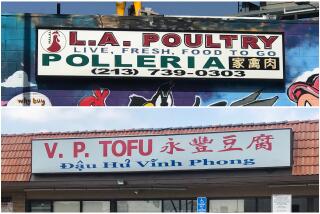Marketplace, Faire Spotlight African Culture
- Share via
Past colorful exhibits of African-style clothing, dolls, masks and jewelry at Rancho Cienega Park on Sunday was a simple, unpretentious exhibit: a traffic light, a doorknob, a lunch pail, a dust pan.
They were among dozens of inventions by African-Americans included in a museum set up at the Los Angeles African Marketplace and Cultural Faire, held the past two weekends and ending at 6 p.m. today.
“We need to learn of the contributions by African-Americans in this country, things you use everyday, that have made our lives easier,” said Valerie J.R. Banks-Shealy, a Los Angeles author and publisher who conceived the idea for a Black Inventions Museum four years ago.
The exhibit has no permanent home because of a lack of funding, so Banks-Shealy takes the collection to schools and public events as a way of reinforcing a positive image of black Americans.
“Many of these things have been somewhat hidden from our education,” she said, gesturing toward a table where a blood plasma bag, a fire extinguisher and a gas mask--all African-American inventions--were displayed. Blood plasma was developed by African-American physician Charles R. Drew, for whom Los Angeles’ Drew University Medical School was named.
The Los Angeles African Marketplace is meant to highlight the positive effect of African culture worldwide. The event has “grown from 10 booths and one stage in 1986 to what you see today--300 booths and five stages,” said spokeswoman Pat Taylor. A separate children’s area featured a puppet theater, storyteller and face painting.
This year, about 200,000 people have come out to the park near King Boulevard and Rodeo Road to attend the festival, Taylor added, which is partly sponsored by the city of Los Angeles Cultural Affairs Department.
On one stage, children with the new Performing Arts Dance Theatre performed traditional African dances and other numbers. “We’re 2 weeks old, we’ve been practicing everyday and we’re still evolving,” said Deborah Dailey, the group’s artistic director, sounding half-proud, half-worried about how things would turn out.
But the audience was soon clapping enthusiastically as her young performers, ranging from 5 to 18, never missed a beat. And there were loud cheers for 15-year-old Dwayne Taylor, in a straw costume and war paint, who combined a breathtaking series of back flips with his dance steps.
“I’ve been doing this all my life,” the youngster said calmly when he was finished, “along with other kinds of things. I sing, too.”
Food vendors sold roast goat from Trinidad, couscous from Morocco, spicy chicken from Jamaica and Louisiana catfish. Displays of African-style clothing, baskets and other wares covered the booths.
One display had no African theme but offered a new angle on weight loss. Under a huge sign promising to “Sleep Away That Tummy. No Dieting No Exercise,” Chandla Shadd sold what she called “tummy trimmers,” which looked like weighted belts. “Your breathing causes an isometric exercise,” Shadd said, “and it breaks down fatty tissue.”
At another booth, Marcel Antoinette sold baby clothes she had fashioned from brightly colored African cottons. “I didn’t mean to have this as a business because I do custom clothing for adults,” said Antoinette, who has designed costumes for Paula Abdul’s backup singers. “But I just had a little girl, and I started making her little outfits. Then people were asking me where could they get them, and the next thing I was making them to sell.”
She also sold T-shirts designed by her brother; one read: “Racism Keeps the Old School in Session. Let’s Close It Down.” Around the fair, many T-shirts had printed messages, one with Martin Luther King’s words “I have a dream,” and others calling for people to vote.
There were also reminders of the riots in one T-shirt for sale reading, “Free the LA 4,” for the defendants in the Reginald O. Denny beating. And some caps carried a slogan shouted frequently during the unrest: “No Justice, No Peace.”
More to Read
Sign up for Essential California
The most important California stories and recommendations in your inbox every morning.
You may occasionally receive promotional content from the Los Angeles Times.










